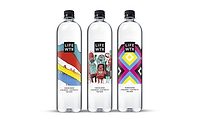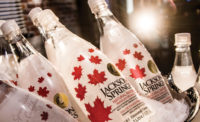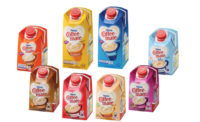The challenges of PET packaging design in the beverage industry
Plastic offers flexibility, sustainability for brand owners

Why do shoppers choose to buy one drink instead of another in a supermarket? Is it the design, the brand, the label, the package material or the drink itself? For most consumers, the reality is that the final decision often is the result of several considerations.
This illustrates that packaging design, which some consider merely an end to producing an attractive yet functional package, is really much more. It is an important and integral part of the purchasing decision. Today’s producers of beverages face many challenges when planning the packaging of mass-produced liquid products. This is particularly true for PET bottles, which offer such a wide range of shape, size and appearance possibilities. Many different factors should be carefully considered throughout the design process if PET packaged drinks are to be a commercial success, and ultimately taken from the supermarket shelf by consumers.
Changing world, changing industry
To understand packaging design, we first need to understand the consumer, and that starts with understanding the changing world in which we live. One significant trend affecting us all is the continued population growth globally. As the number of people living on the planet increases, the number of beverages required to meet new levels of demand grows too. Today, many people travel more freely around the world compared with in the past. As a result, many countries are becoming much more racially and culturally diverse.
Increased numbers of people also are moving from rural areas to the city. This trend toward urbanization is creating greater pressure on the infrastructures of even larger conurbations.
Globalization is having its effect, too. The economies of many countries in the Middle East, South America, Africa and Asia now are booming. In many developing countries, a new “middle-class” of consumers is growing. Not surprisingly, this demographic, with greater disposable income, now is aspiring to the same lifestyle they see being enjoyed by people in more established economies. This includes consumer products and beverages. As international drink producers look to generate and increase sales, they are moving into previously uncovered territories. Many popular, well-established brands from Europe and the United States are, therefore, becoming an increasingly common sight in these newly developing countries.
Changing needs, similar expectations
Not all new consumers, however, want those beverages to which they are increasingly exposed. Many are looking for products based on their own tastes, cultures and traditions. There are, nevertheless, similar expectations in terms of packaging. Consumers expect it to be appealing, informative and easily identifiable. They want it to protect the quality and the integrity of its contents, conserving the freshness and taste for as long as possible. With the increasing popularity of health drinks, fruit juices and liquid dairy products, this role takes on added significance, given that such drinks tend to require extra protection.
Consumers also expect packaging to reflect their changing lifestyles. Smaller, individual, on-the-go formats are better suited to the lifestyles of today’s more mobile generation, while larger multi-pack formats are ideal for the separate habits of today’s bigger families. One direct result for bottlers and drink producers is the need to increase the number of formats provided to keep retailers supplied with sufficient SKUs to satisfy these changing consumer habits.
Today, people also are more environmentally aware. They increasingly understand the need to recycle goods and materials in order to conserve natural resources. They also appreciate the need to be considerate of our environment and to reduce waste — especially the packaging from commercial goods.
When it comes to beverage packaging, producers already have been taking big steps to achieve greater sustainability. This aspect is very much an integral part of today’s design process and needs to be considered at the very outset of every new project. For PET bottlers today, the overriding sustainability need is usually for optimum cost effectiveness. This means high-speed production lines bottling large volumes of packaged beverages in short times. It also requires bottles that are as light as possible, leading to a design practice known as lightweighting. Flexibility of line conversion, to introduce a new bottle design or product quickly and efficiently, also can be important. A thorough appreciation of these market drivers and, more importantly, how to achieve them, is therefore essential when designing any new PET packaging solution.
The rise of PET bottling
PET is a unique packaging material. It meets the expectations and needs of beverage producers and consumers alike. It is light in weight, shatter-resistant, fully recyclable, and offers design flexibility at a competitive price. It is, therefore, not surprising that its use has enjoyed strong growth during the past 30 years.
Although store shelves these days are understandably packed with many similar items, the purchasing decisions of consumers often are made in a matter of milliseconds. To give their beverages individuality, to make them stand out from the crowd, and to catch the consumer’s eye, producers are increasingly turning to PET to create bottles with distinctive shapes, attractive labels, high quality and optimal lightweighting.
The performance characteristics of PET offer many design possibilities compared with other materials. Its transparency and clarity also are key assets. Consumers naturally want to be able to see and fully appreciate the bottle’s contents and to determine its quality. PET bottles also are easily transportable. Being light yet resilient, convenient and re-sealable, PET bottles are very convenient. In fact, PET is the only material suitable for the whole range of sizes for the family — from the smallest individual formats to the largest bulk containers. In summary, it is suited to the demands of today’s world.
Bringing packaging design to life
To take advantage of PET requires the necessary expertise, and this starts at the design phase. Having an experienced and creative design team is important to provide beverage producers with invaluable support throughout each essential step of the packaging process. This includes original design sketches, models and feasibility studies through to full global production solutions. This combination of technical and design expertise should be brought to bear on all projects and for all packaging materials, formats, lightweighting, line conversions and energy-saving possibilities.
From the initial conceptual sketch, 3-D drawings can be produced addressing technical considerations such as finished volume and weight. Computer-generated images then are developed to give a closer simulation of the actual product. At Sidel, the bottle’s mechanical performance is calculated through the company’s Finite Element Analysis (FEA)?system. Samples then are produced with full container qualification. These undergo rigorous testing protocols.
Moving into the industrial production phase of the whole process, molds and package-dependent parts then are created, when the intended design is ready for immediate commercial up-scaling. (Package-dependent parts are those elements of a production line that need to be replaced to convert the line to produce a new bottle design or new liquid.) When undertaken together as a holistic process, this can significantly reduce the crucial time-to-market it takes to get the finished product launched and ultimately into the hands of the consumer.
Creating value for beverage producers
Other useful capabilities from a solutions provider can include in-depth packaging knowledge, microbiology expertise, equipment design and line engineering. By considering specific customer requirements such as storage, transportation, necessary shelf life, and cost and sustainability targets, optimal packaging solutions can be achieved utilizing the most appropriate materials, sizes, shapes, formats, caps and labels.
With even the most delicate beverages, such as juices, teas, flavored drinks or liquid dairy products, an intimate understanding of the interaction between certain liquids and various packaging materials can help predict the behavior between the two elements over any period of time. This possible interaction between product and packaging is, of course, critical to shelf life. Beverage ingredients, composition, viscosity, sugar content, pH and carbonation, along with organoleptic qualities (meaning those aspects of the liquid as experienced by our senses, including taste, sight, smell and touch), all need to be considered. Extensive compatibility analyses should be carried out through exhaustive physical and chemical testing. During such testing, products are usually packaged aseptically and then stored under different conditions of temperature and lighting to simulate real-life environments, from the factory floor to the consumer’s home. These tests are then followed by one of the most important trials — sensory analysis, otherwise known as taste-testing. Only by carrying out such rigorous testing for each new product can the most suitable packaging be properly identified.
A lightweight future
The cost of the raw material used to make a PET bottle represents as much as 75 percent of the total cost of ownership (TCO), so it is understandable that the industry is undergoing a significant move toward lightweighting of all new bottles. The typical weight of water bottles holding 1.5 liters of still water, for instance, has fallen from 42 to 22.5 grams during the past 23 years. During that same time, the manufacturing rate for those bottles has increased from 1,000 bottles an hour to 2,250. As lightweighting technology and understanding continue to increase, the typical weight is expected to fall even further to below 20 grams.
However, today’s solutions are not just about lightweighting. They also are about “right”-weighting to protect the product, the consumer and, ultimately, the brand.
Right-weighting with the right blowing system
Bottle design is vital in reducing bottle weight. A lightweighted bottle is, in turn, dependent on the right blowmolding system. The new Sidel Matrix system, for example, offers control functionality that optimizes material distribution across bottles on a production line. In some cases, this can lead to a 50 percent reduction in the variation of bottle wall thicknesses.
Ambitious lightweighting requires full control of material distribution. Sidel’s Intelliblowunit, therefore, controls all process parameters during the blowing phase. This means making real-time adjustments. The unit analyzes key blowing parameters and continually adapts each blowing station to ensure the bottles are blown with identical material-distribution patterns. It is, therefore, possible to achieve optimal weight without sacrificing consistency or quality.
Holistic approach to beverage packaging
There is a finite limit to the possibilities of lightweighting, and there comes a point when product integrity and performance start to suffer. For this reason, Sidel is combining its lightweighting programs with its carbon amorphous coating, Actis. This is an innovative plasma technology applied in order to reinforce PET barrier protection. This makes aggressive lightweighting with extended product shelf life possible, particularly for carbonated soft drinks, without compromising the recyclability of the PET material.
Greater savings also can be made when considering the whole package. This generally means that, along with a lightweight enclosure, the label itself and a redesigned neck should be included in any design review. Labelling technologies are constantly being refined to reduce the weight of the actual label and to use the thinnest sleeves commercially available. The lower weight of these primary packaging elements brings with it a significant reduction in the energy consumption needed throughout the life of each bottle and, therefore, its overall carbon footprint.
Reactivity and time-to-market
Whether redesigning bottles for existing products or launching a new product, both final product design and related line conversions have to be completed on schedule within timeframes that are as short as possible. With increasing numbers of SKUs, beverage producers and bottlers face the challenge of getting lines adapted as quickly and as efficiently as possible. Project management is an important factor.
Some companies offer services that combine packaging design with original equipment manufacturer (OEM) equipment, parts and project management. This “one-stop” project management can be provided through a dedicated manager who provides a central focal point with a better overview of all the actions needed on the line. The project manager typically will schedule the line conversion work to be carried out by technicians during on-site installation. This holistic approach to the entire bottling process covers blowing, filling, labelling and secondary packaging systems, along with supply and transport logistics. This can help ensure immediate equipment efficiency, a faster time-to-market, and optimal TCO. Some OEM companies also can partner with “pure” design houses to achieve the above gains while also retaining the creative expertise and/or existing relationships of such trusted agencies.
Future sustainability
During the past decade, the industry has seen a significant improvement in the collection streams of PET material in certain countries. Today, the integration of recycled PET, or rPET, into the production process is increasing. There is no significant difference or deterioration in the chemical composition between the recycled version and the original material. Both result in bottles with the same technical characteristics. It has been found that rPET has better re-heating characteristics in comparison with virgin PET resin, although it suffers an increase in discoloration when exposed to several heat-history loops. Partly for this reason, but mostly for reasons of the inadequate supply of sufficient quantities, the production of bottles from 100 percent rPET is not yet realistic. Nevertheless, PET presently is the most effective recycled plastic, offering bottle producers an optimized environmental footprint and maximized recycling opportunities, provided the balance of virgin and recycled material is suitable on each occasion.
However, new non-fossil-based resins are being developed with the ultimate aim of replacing PET, hopefully with improved properties such as mechanical resistance or gas barrier characteristics. Bio-PET also is already being produced based on agricultural resources, with the hope that agricultural waste or by-products might be used in the future.
Meeting the challenges
The selection criteria for a consumer purchasing a drink are based on numerous factors. The packaging in which the drink comes is undoubtedly an important part of that equation. Attention to packaging and the various stages involved in the process are, therefore, critical.
Launching a new product, producing a new bottle capacity or an innovative shape, or simply lightweighting an existing bottle requires knowledge, expertise and experience. A holistic approach, recognizing the importance of each element and, importantly, how they work together, can provide an optimum way to meet such packaging design challenges. It is not surprising, then, that this approach is nearly always adopted for those more popular drinks chosen from the supermarket shelf by consumers.
Related: Using packaging shape to create beverages that stand out
Looking for a reprint of this article?
From high-res PDFs to custom plaques, order your copy today!








